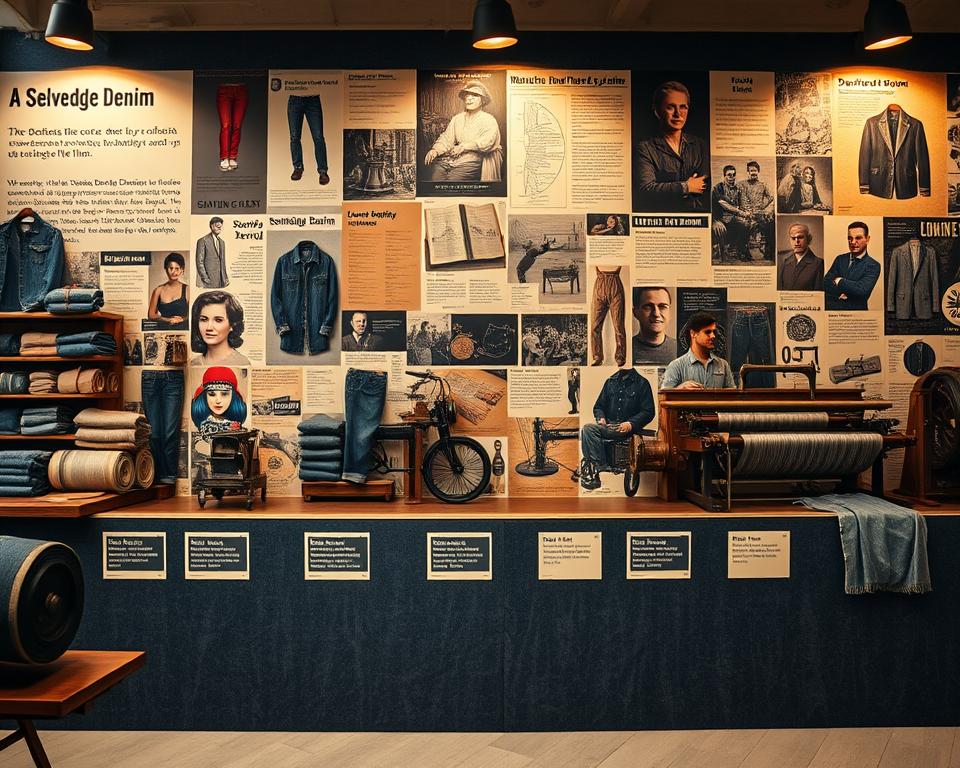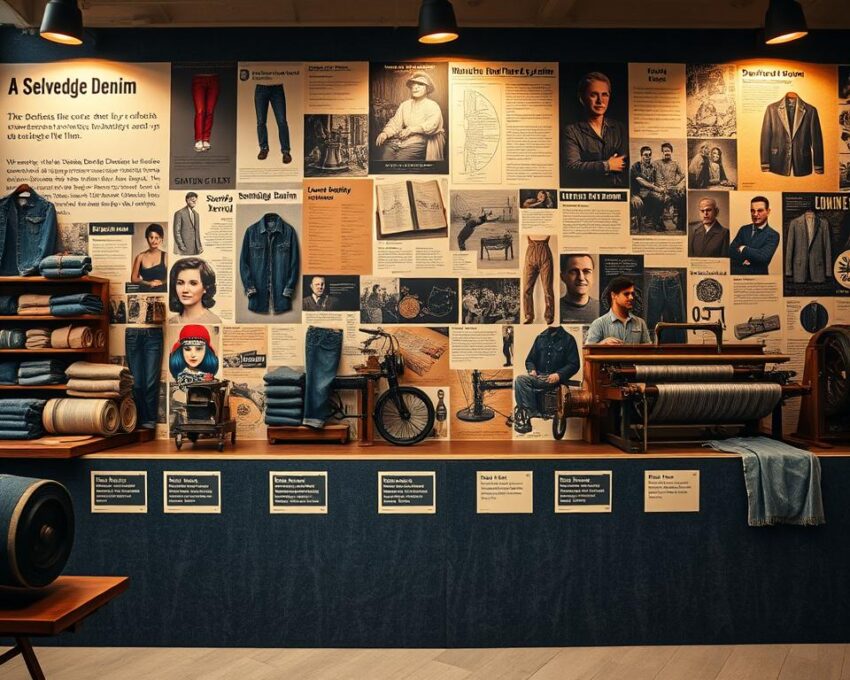A Comprehensive Guide for Superior denim Selvedge Fabric
Have you ever questioned the reason certain jeans seem as though they are built for endurance eternity? Everything revolves around the components and craftsmanship. For example, the increasing popularity of premium selvedge. This isn’t just any textile—it’s a testament to superiority and heritage.
Currently, a growing number of people are opting for these everlasting materials for their sturdiness and classic ewingfly denim appeal. Whether you’re a home sewing sewist or a denim lover, there’s a unique quality about using superior natural fiber and stitching. It’s not just about constructing jeans; it involves fashioning something that tells a story.
At Core Fabrics, we’ve selected a range of 14.25oz organic cotton and flexible variants. These materials are ideal for a spectrum ranging from raw jeans to high-fashion jacket designs. Ready to explore the world of top-tier fabrics? Let’s dive in.
Understanding Denim Selvedge Fabric?
Why do particular jeans set themselves apart with their signature, finished without extra steps edges? The key is found in the selvedge denim, a superior textile known for its durability and vintage aesthetic. In contrast to standard textiles, this fabric is fashioned with traditional methods that have proven their worth.
Understanding Selvedge Denim
Selvedge denim is produced via old-style shuttle looms, which produce narrow widths of about 30-35 inches. They intertwine the material in a method that delivers self-finished edges, often highlighted by a signature red line. This method confirms the material is tightly woven and highly durable.
Contemporary looms, on the other hand, yield broader fabric but lack the comparable degree of skill. Minor flaws in selvedge, like leg twists or uneven textures, are celebrated as features of its character. This philosophy, known as “wabi-sabi”, exalts the appeal of inherent flaws.
How Selvedge Denim Is Made
The production of selvedge denim involves a detailed process. These looms weave the filling yarns back and forth, resulting in a dense and resilient material. Unlike modern methods with new-age looms, which emphasize quick production and efficiency over quality.
Brands like Karson Denim preserve time-honored Japanese weaving techniques from the 90s. They intentionally include anomalies to maintain the true character of the textile. Every item is assessed on a 4-point system, ensuring it satisfies the highest standards of excellence.
| Feature | Selvedge Denim | Modern Denim |
|---|---|---|
| Width | 30-35 inches | 60+ inches |
| Fabrication Method | Shuttle Loom | New-Age Loom |
| Surface | Non-uniform, Raw | Even |
| Sturdiness | Exceptional | Moderate |
“The beauty of selvedge resides in its natural irregularities—each irregularity speaks of skill and legacy.”
The Legacy of Selvedge Denim
From humble beginnings to worldwide renown, the narrative of these fabrics is multifaceted and motivational. Originally developed as hardwearing clothing in 17th-century France transformed into a signifier of everlasting fashion and artistry.
Origins in Traditional Weaving
The foundation of this textile reaches back to Nîmes, France, where it was known as “serge de Nîmes.” First intended for laborers, it was constructed with hardwearing cotton and thread. Its durability made it a favorite among laborers during the Gold Rush.
In the 20th century, it had become a cornerstone for trousers. The shuttering of the Cone Mills White Oak factory became a pivotal moment. This transition opened the door for Japanese craftsmen to reintroduce old-world weaving methods.

Modern Developments in Denim
Post-WWII, Japan adopted vintage American culture. Artisans repaired old looms to produce authentic reproductions. This commitment to quality ensured the continuance of selvedge as a niche product.
Currently, breakthroughs from Italy and Turkey have brought forth eco-friendly combinations and elastic options. These improvements have widened the allure of this timeless textile. Within Core Fabrics, we source globally, from Montréal to Asia, to bring you the best excellence.
“The legacy of selvedge is a celebration of the perennial merit of excellence and heritage.”
Reasons to Select Selvedge Denim?
Why does selvedge denim distinguish itself in the universe of superior materials? Its unique qualities and incomparable robustness render it popular among aficionados and creatives alike. Be it that you are crafting trousers or a tailored jacket, this textile provides a mix of heritage and contemporary charm.
Distinctive Attributes of Selvedge
Selvedge denim is renowned for its dense construction, which enhances durability and fade potential. In contrast to common fabrics, denim selvedge fabric is produced using classic shuttle looms, yielding a tightly packed and extra robust material. Such a process guarantees that every item possesses a singular finish and personality.
Here’s what makes it special:
- Hairy, rigid raw denim juxtaposes against pre-washed comfort stretches.
- Sanforization stabilizes the fabric for consistent measurements, while natural variants entail a unique shrinkage journey.
- Variants include 9.5oz Eco Finish to 14.25oz Organic, catering to different needs.
Durability and Longevity
One of the key attributes of selvedge denim is its enduring nature. The dense fabric structure boosts robustness while enabling unique fading patterns over time. This establishes it as a wise purchase for those seeking classic garments.
Key points to consider:
- Mid-weight fabrics from 12oz to 14oz work well for tailored jackets and evolving jeans.
- Opt for the 14.25oz True Indigo for traditional jean lifespan.
- Green alternatives, including recycled cotton with indigo blends, contribute to a sustainable collection.
Core Fabrics offers an assortment of products tailored for every requirement. Spanning from raw finishes to sanforized treatments, each selection is designed for superior quality and value.
Selvedge vs. Wide Denim: A Comparison
For making durable and stylish garments, the decision of material plays a crucial role. Among the prevalent selections are selvedge and wide denim, each with unique characteristics. Knowing how they differ assists in selecting the ideal material for your creation.
Distinct Weaving Methods
Selvedge denim is produced using traditional shuttle looms, resulting in slim widths of 30-35 inches. This selvedge denim jacket process generates tightly woven edges, often accented with a distinctive red line. Conversely, wide denim employs advanced projectile looms, yielding spans of 60+ inches.
Shuttle looms are slower, producing about 3 meters per minute, while projectile looms can produce up to 30 meters per minute. This difference in speed impacts both the price and the texture of the end result.
Advantages and Disadvantages
Selvedge denim is known for its premium quality and durability. Its limited breadth suits it well for projects where visible hems or patches are desired. However, it can be more expensive, generally priced at $23 per meter.
Wide denim is economical, typically costing $8 per half-meter. Its expansive dimension reduces waste, making it suitable for extensive endeavors like furniture covering. However, it does not feature the signature finished border of selvedge.
| Feature | Selvedge Denim | Wide Denim |
|---|---|---|
| Measurement | 30-35 inches | 60+ inches |
| Technique | Shuttle Loom | Projectile Loom |
| Rate | 3m per minute | 30m/min |
| Expense | $23 per meter | $8/half-meter |
For defined borders as seen in Grainline Thayer jackets, selvedge is favored. For larger projects, wide denim offers better value and efficiency. Weigh your requirements carefully to decide.
How to Use Selvedge Denim
Working with premium materials can elevate your sewing projects to the next level. Be it making jeans, blazers, or skirts, understanding the basics of yardage, sewing techniques, and care ensures a professional finish. Let’s explore ways to best utilize this classic fabric.
Material Requirements for Jeans and Jackets
It is essential to compute the correct fabric amount when designing your creation. Approximately 3-3.3 yards is necessary for men’s jeans, considering defects and shrinkage. Trucker-style jackets generally demand about 3.3 yards, while a skirt often needs 2 yards.
Creative pattern placement can help manage imperfections in the material. Instead of cutting around defects, consider integrating them into your design for a unique look.
| Item | Fabric Needed |
|---|---|
| Men’s Jeans | 3–3.3 yards |
| Work Jacket | 3.3 yards |
| Skirt Item | 2 yards |
Tips for Sewing and Care
Using the right tools and techniques ensures a polished result. Opt for #70–110 needles and foot accessories designed for heavy materials. Use Gütermann rPET thread for effective contrast stitching.
Here are some additional tips:
- Employ a tailor’s clapper to achieve crisp creases without gloss.
- Our denim kits from Core Fabrics comprise topstitch thread, rivets, and 9mm jeans buttons to ensure a refined result.
- Structured edges, essential for jackets, are best achieved with selvedge.
Proper care extends the life of your creations. Limit washing and allow to air dry for optimal durability. With these tips, your projects will stand the test of time.
In Summary
Crafting with premium materials isn’t just about durability—it’s about creating something with character. Selvedge denim epitomizes this principle, merging artisanal charm with enduring excellence. From jeans to tailored jackets, every stitch of this material conveys a narrative.
With Core Fabrics, unleashing your creative potential is effortless. Experience our swatch service to gauge texture and weight prior to purchase. Furthermore, take advantage of free shipping for orders above $150 USD in North America.
Eco-friendly mixtures and classic washes are paving the way for the next generation of cotton fabrics. They open fresh avenues for merging sustainability with chic style.
Eager to explore top-tier textiles? Shop now and discover the value of crafting with purpose. Your next project could be a timeless piece that lasts for years to come.
